|
Apr
14
2025
|
|
Posted 247 days ago ago by Admin
|
|
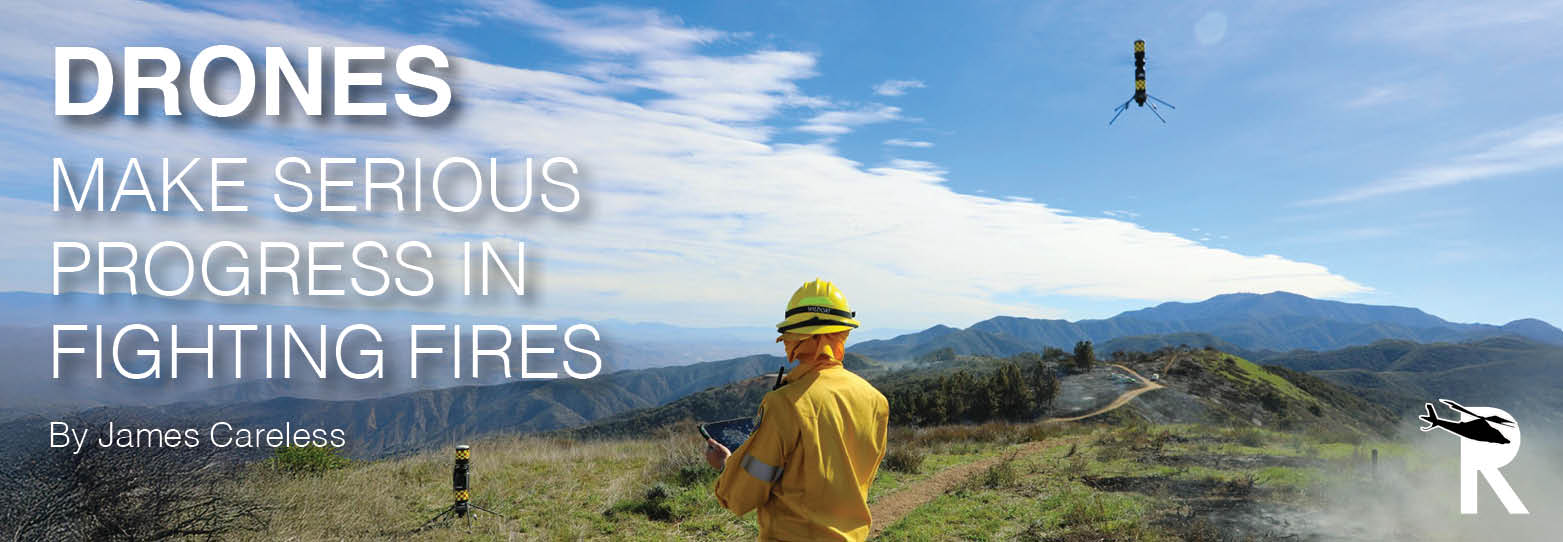
Whether through fighting fires directly or aiding those who do, drones are making serious progress in saving lives and property. Here is a brief rundown of some of the amazing things that drone technology is doing for firefighting today.
A Different Approach to Firefighting Drones
For those platforms who provide ‘eyes in the sky’ for firefighters, many of the firefighting support drones used today are based on quadcopter designs. While that’s an architecture that has proven reliable and effective in many situations, [aviation/aerospace] systems are constantly evolving, and the quadcopter is noteworthy for “its lack of evolution since its introduction as a hobby-grade system,” said Paul Fermo, VP of Business Development at Ascent AeroSystems. Massachusetts-based Ascent AeroSystems takes a different approach to unmanned systems; designing and building its Group 1 UAVs around a coaxial design that—supported by the laws of physics and aerodynamics—is proven to deliver superior performance in even the most demanding environments.
Built with a unique cylindrical core featuring two counterrotating blades centrally stacked on the same axis, Ascent AeroSystems refers to their stable and powerful propulsion system as ‘the coaxial advantage’. “In contrast [to standard quadcopter design], the coaxial design is both proven and represents a significant step forward in the evolution of rotary-wing and UAV technology,” Fermo told Rotor Pro magazine, “delivering exceptional lift, unmatched flight stability in even the most challenging conditions, and enhanced power efficiency versus comparably sized multirotors — all in a compact, rugged, all-weather form factor. And, with all the critical components sealed within a waterproof core, Ascent platforms are also able to operate in extreme conditions that might ground other aircraft — like high winds, heavy smoke, intense heat, or low visibility.”
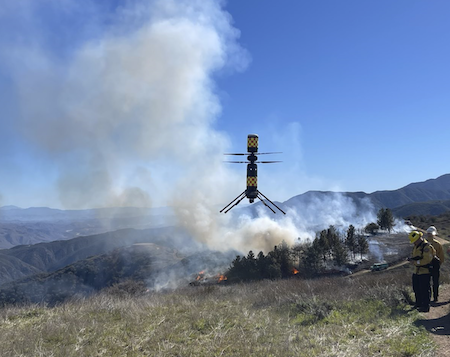
It’s these capabilities, supported by the same aircraft-grade components and FAA-certified manufacturing processes found in crewed aircraft, that make Ascent AeroSystems’ coaxial drones a standout in their class and well-suited for firefighting duties. As well, “the cylindrical form factor is inherently stronger, dispersing both impact and heat stress more effectively than typical multirotors,” said Fermo. “When paired with our modular open architecture, firefighters can swap radios, upgrade sensors, or integrate new software — all without needing a new airframe.”
Fighting Fires Directly
Need to fight a high-rise fire far above the reach of ground-based fire engines? Then it is time to call in EHang drones like the company’s EH216-F to battle flames from the air.
“As urbanization accelerates, the heights and density of buildings increase fire hazards, making traditional firefighting methods — such as rescue ladders — less effective,” said Tian Xing He, EHang’s vice president. “The EH216-F was specifically created to tackle these difficult situations, offering significant advantages for high-rise fire response.”
When it comes to flight parameters, the EH216-F can operate at a maximum altitude of 600 meters/1,968 feet, making it suitable for fighting high-rise building fires. The drone can carry up to 100 liters/26 gallons of firefighting foam and six fire extinguisher projectiles per flight.
The EH216-F uses an onboard visible-light zoom camera to detect fires precisely and has a laser aiming device for targeting, and it can drop window breakers and fire-extinguishing projectiles onto targets. Multiple EH216-Fs can be deployed simultaneously and controlled using EHang's proprietary command-and-control system, which allies for centralized management and quick coordination during emergencies.
“In practical terms, the EH216-F has been deployed in high-rise fire rescue drills and has demonstrated its effectiveness in reducing response time and preventing casualties,” he said. “It complements traditional firefighting methods and can be deployed to assist firefighters within a 3 kilometer radius of the station. All EHang eVTOLs feature the full redundancy design, which means that all components have their backup systems. Even in the case of special situations such as power loss and GPS signal loss, the eVTOL still keeps a stable attitude and safe flight, and performs accurate firefighting normally.
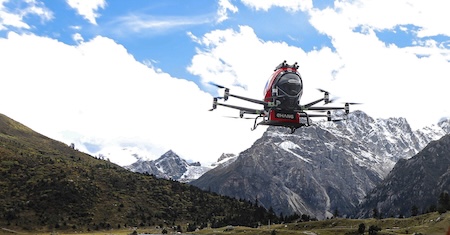
Another option for direct autonomous aircraft firefighting is an uncrewed Sikorsky Black Hawk helicopter equipped with Sikorsky’s MATRIX™ flight autonomy software and Rain’s autonomous aerial wildfire containment technology. The two have been working together to prove this technology through numerous demonstrations, such as an October 2024 flight where three successful Bambi Bucket water drops were executed.
“There are three main components to Rain's technology,” said Rain CEO Maxwell Brodie. “The first is the Rain Mission Control Tablet that allows for the Autonomy Supervisor to supervise and receive sub-second mission data on Rain-equipped aircraft. The second is Rain Network
Control that ingests ignition locations and dispatches the aircraft, relays mission data between the aircraft and the human supervisor and generates mission plans for approval. The third component is a mission computer on board the aircraft with Rain software that allows it to generate suppression plans and autonomously target and suppress wildfires.”
According to Brodie, Rain is working to transition its autonomous aerial firefighting technology into service in collaboration with leading fire agencies. “Over the past few years, Rain has demonstrated on several occasions the ability to rapidly and autonomously suppress test fires with a Rain and Sikorsky MATRIX-equipped autonomous Black Hawk helicopter,” he said. “We are excited to familiarize, train and operationalize our autonomous wildfire response technology in support of fire professionals.”
Helping On Scene
Extinguishing flames from the air is just one way that drones fight fires. A case in point: Airbus’ all-weather Flexrotor VTOL drone, which has been designed for commercial, defense, and industrial applications, can aid firefighters in areas such as intelligence, surveillance, mapping, and environmental monitoring, offering innovative solutions for challenging operational environments.
“The Flexrotor is a highly versatile uncrewed aircraft system designed with features that make it especially useful for firefighting,” said Ben Motazed, Flexrotor’s business development lead. “It can stay airborne for an average of 12-14 hours (with payload and fuel tank), allowing for sustained monitoring of wildfire conditions. Equipped with electro-optical and infrared cameras, the Flexrotor provides real-time imaging through smoke to identify hotspots and assess fire progression.
At the same time, the Flexrotor is easy to deploy and operate. “The system packs into a 50 kg. / 110 pound box, making it easy to transport on pickups or via special operations aerial insertions,” Motazed said. Launching and landing this CTOL requires no more than a 3.7m x 3.7m (12 feet x 12 feet) landing zone, and the Flexrotor can be airborne in less than 30 minutes (including fueling and ground control setup).
“Once aloft, it combines helicopter-like thrust-borne lift with the wing-borne efficiency of a fixed-sailplane, and the Flexrotor’s ability to fly pre-programmed patterns and revisit specific locations repeatedly makes it ideal for ongoing fire assessment, including monitoring firebreak effectiveness and weather changes,” said Motazed. “The Flexrotor is already being used for firefighting. It was first used for conservation and anti-poaching efforts in 2016, but we quickly recognized its potential for firefighting due to its durability, efficiency, and unique design.”
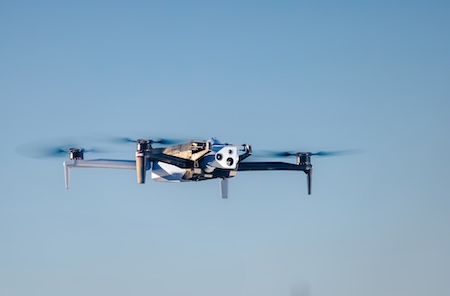
Enhanced situational awareness is also the rationale behind the Skydio X10 drone. “Its FLIR Boson+ thermal sensor allows firefighters to see through smoke, identify hotspots, and locate individuals in dangerous and hard-to-reach places,” said Jason LaFond, Skydio’s customer success manager for public safety. “These capabilities are essential for assessing scenes, allocating resources, and ensuring safety for first responders.”
According to LaFond, the Skydio X10 can be deployed in under 40 seconds. “With 5G connectivity and live streaming capabilities using Skydio ReadyLink, real-time video feeds can be shared directly with command units and ground teams,” he said. “This enables a coordinated response and ensures that all stakeholders receive accurate and up-to-date information.”
Meanwhile, the Skydio Dock for X10 is an autonomous docking station that can be prepositioned to deploy an X10 drone remotely in 20 seconds or less. This allows fire departments to preposition X10 drones in high risk areas, providing them with rapid situational awareness when fires break out.
“The X10 is effective for urban and wildland firefighting,” said LaFond. “Operators can use it to quickly scan buildings for hotspots, assess structural stability, and monitor firefighter safety. For wildland fires, the X10 can survey large areas to track the spread of fire, assist in developing a strategy for containment, and identify safe zones for responders.”
“At present, departments such as Boston Fire, Tulsa Fire, Nashville Fire, Palm Beach County Fire Rescue, Orange County Fire Rescue (FL), Tallahassee Fire Department, and Southern Manatee County Fire & Rescue are deploying Skydio drones to assess fire size and spread before responders arrive, to identify hotspots during operations, and to provide live updates to command centers,” he added. When Hurricane Milton damaged an oil storage facility in Florida that contained 4 million gallons of gasoline, “Rich Gatanis, a firefighter, haz-mat, and UAS specialist with Southern Manatee Fire & Rescue, used Skydio drone technology to safely inspect the damaged infrastructure and evaluate the site's condition while livestreaming the operation to key state stakeholders via ReadyLink,” said LaFond.
UAV Navigation-Grupo Oesía is a Spanish company that develops guidance, navigation, and control solutions for drones.” We have developed a range of solutions to be used in UAVs equipped with advanced technologies specifically designed for firefighting,” said Miguel Manrique, the company’s rotary-wing solution leader. “Our autopilots include essential features for emergencies, making unmanned platforms a crucial element in firefighting operations. Our systems also feature full integration with high-definition cameras, enabling a camera-guided mode that allows the drone to automatically follow target coordinates provided by a camera, either through object tracking or manual input.”
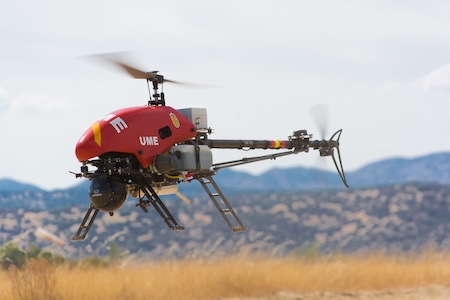
As well, UAV Navigation-Grupo Oesía has developed capabilities such as automatic cargo drops at predetermined waypoints, and algorithms to allow operators to send drones to specific locations at specific times. “Our flight control systems are actively used for example by the Spanish Emergency Military Unit (UME) which employs our client’s Alpha Unmanned Systems A800 helicopter,” Manrique noted. “In Spain, the Spanish Emergency Military Unit (UME) is a dedicated military force established to intervene in situations requiring the preservation of citizens' safety during natural disasters, high-risk scenarios, or other special public needs.”
To conclude this article on drone-based firefighting, we end with Drone Amplified, a company that uses drones for controlled burns. “Our IGNIS product is a groundbreaking aerial ignition system designed specifically for wildfire management,” said Dan Justa, the company’s vice president of business development. “Mounted on drones, IGNIS enables precise, efficient, and safe execution of prescribed burns and backburns, which are critical for controlling and preventing wildfires. It replaces traditional methods that rely on helicopters or ground crews, significantly reducing risks and costs.”
IGNIS is controlled through Drone Amplified’s DA-Flight app, offering features like real-time mission planning, telemetry, and automated ignition patterns. “Our systems are deployed nationwide for operations on fires and for prescribed burns,” Justa said.
READ MORE ROTOR PRO: https://justhelicopters.com/Magazine
WATCH ROTOR PRO YOUTUBE CHANNEL: https://buff.ly/3Md0T3y
You can also find us on
Instagram - https://www.instagram.com/rotorpro1
Facebook - https://www.facebook.com/rotorpro1
Twitter - https://twitter.com/justhelicopters
LinkedIn - https://www.linkedin.com/company/rotorpro1